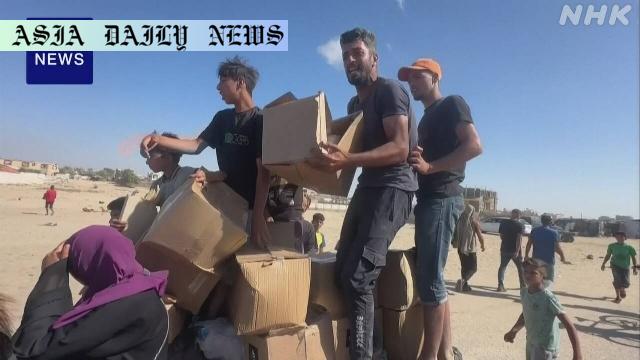Gaza aid: Israeli and US-backed centers distribute food amidst severe shortages, replacing UN channels under tense conditions.
Key Point 1: Israel and US introduce new Gaza aid centers amid a humanitarian crisis.
Key Point 2: UN objects to the current distribution system, emphasizing the need for border reopening.
Key Point 3: Local residents express relief but ongoing shortages remain severe.

Introduction: New Aid Efforts in Gaza Amid Severe Shortages
Recent announcements from Israeli officials highlight a new chapter in international efforts to address the humanitarian crisis unfolding in Gaza. For months, a blockade has severely restricted aid flow, leaving Gaza’s residents to grapple with dwindling supplies of essential items. The introduction of US-backed aid distribution centers aims to bridge this gap, providing critical resources to thousands of households in need. Nevertheless, this initiative has sparked intense debate and scrutiny from global organizations and local authorities alike.
Details of the Aid Distribution System
Israeli officials, in collaboration with the United States, have established four humanitarian aid centers in Gaza, two of which are now operational in Rafah, a city in the southern region of Gaza. According to the Gaza Humanitarian Foundation, these centers have already distributed food packages to thousands of people. This initiative comes after nearly three months of limited humanitarian access to the enclave, a strategy employed to pressure Hamas in coordination with ongoing military operations.
The centers focus on providing essential food items to families who have been struggling for daily sustenance. Although these efforts have been welcomed by many residents, critics argue that they fall far short in meeting the area’s escalating needs. Gaza authorities estimate that at least 500 trucks of aid are required each day to alleviate the severe shortages of food, water, and medical supplies.
UN Reaction and Larger Implications
Despite these efforts, the United Nations has raised significant objections to the new aid distribution system. Jens Laerke, a spokesperson for the UN Office for the Coordination of Humanitarian Affairs, dismissed the initiative as inadequate. He reiterated the organization’s demands for reopening Gaza’s border crossings to allow comprehensive relief efforts.
Previous aid routes facilitated by UN agencies have faced criticism from Israeli and US officials, who allege that supplies often ended up in the hands of Hamas. Although UN representatives have denied these allegations, the new system could signal a shift in how international humanitarian aid is distributed in conflict zones. However, concerns over impartiality, fairness, and sufficiency of the aid remain prominent.
The Human Impact of Aid Distribution
Gaza residents have greeted the aid efforts with a mix of relief and uncertainty. One recipient, expressing his gratitude, remarked, “We are patient and resilient people, hungry people who must be filled.” Families now have access to food packages that could temporarily alleviate their struggles, though for many, the uncertainty of long-term assistance looms heavily.
Given the scale of the crisis, these centers, while well-intentioned, fall short of alleviating the wider humanitarian challenges. Water shortages, a lack of medical supplies, and worsening sanitary conditions exacerbate the existing difficulties for the population of over 2 million residents.
Moving Forward: Solutions and Challenges
As the humanitarian crisis in Gaza continues, achieving a balance between security and humanitarian needs presents significant challenges. The decision by Israel and the US to implement direct aid distribution is an attempt to bypass alleged inefficiencies associated with previous UN-led efforts. However, critics argue this is merely a stopgap measure.
Opening Gaza’s borders and facilitating the flow of sufficient aid are critical components in addressing the systemic issues causing the crisis. Without ensuring the requisite daily deliveries and the involvement of impartial, international organizations, the long-term viability of these initiatives remains in question.
Meanwhile, international advocacy groups continue pressing for broader measures to address the root causes of this crisis. Restoring access to essential services and critical infrastructure remains essential to ensuring the well-being of Gaza’s citizens. While the new distribution centers are a positive step, they are far from the comprehensive solution the people of Gaza so desperately need.



Commentary
The Promise and Limitations of Aid Distribution
The newly introduced US-backed aid distribution centers in Gaza present a glimmer of hope amidst a mounting humanitarian crisis. Israel and the US have positioned these centers as a more effective alternative to the UN-led aid system, which they claim has been compromised by diversions to Hamas. While this approach seems noble in its intent, there are pressing concerns that cannot be ignored.
Addressing the Scale of the Crisis
One of the major limitations of the new system is its scale. Gaza authorities have stated that 500 trucks of supplies are necessary daily to meet the population’s needs. In this context, the current system appears inadequate. Although the centers have provided relief to thousands of families, the broader question remains—how will this initiative address the overwhelming need for food, water, and medical aid across Gaza over the long term? Such short-term strategies risk offering symbolic solutions to systemic problems.
Balancing Security with Humanitarian Needs
The new aid system also raises ethical questions about balancing security concerns with the immediate needs of Gaza’s population. While Israel and the US seek to prevent aid resources from falling into the wrong hands, this pursuit cannot come at the expense of depriving innocent people of essential resources. Undermining the capacity of established organizations like the UN may weaken a system that was designed with impartiality and equity in mind.
A Call for Sustainable Solutions
Ultimately, the introduction of these centers reinforces the urgent need for international collaboration and sustainable approaches to humanitarian aid. Rather than developing parallel systems, engaging all stakeholders—including NGOs, local governments, and international bodies like the UN—would ensure a more coordinated and effective response. This crisis requires more than aid; it demands a comprehensive plan that addresses the underlying issues affecting Gaza’s people.